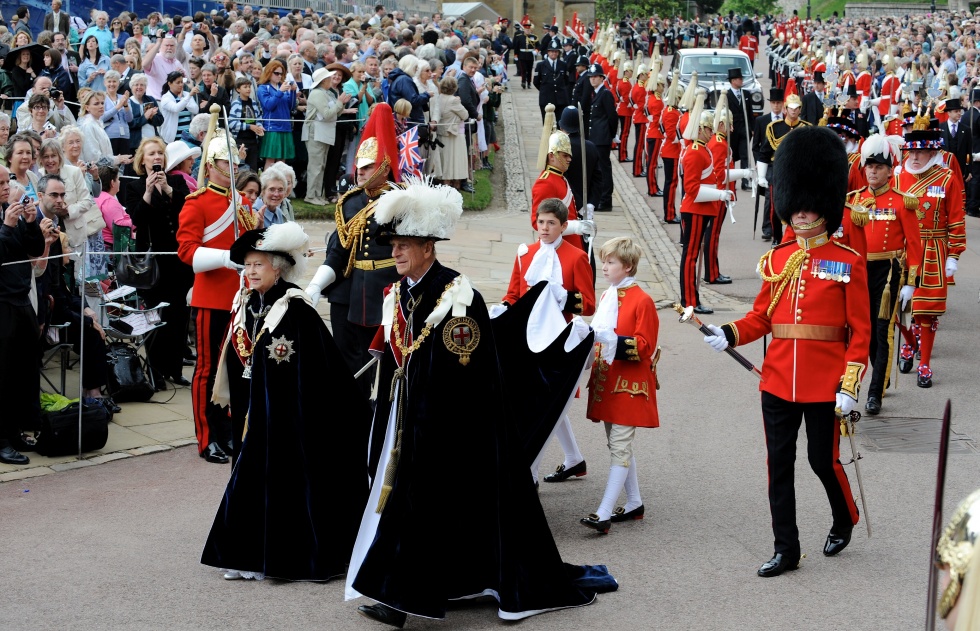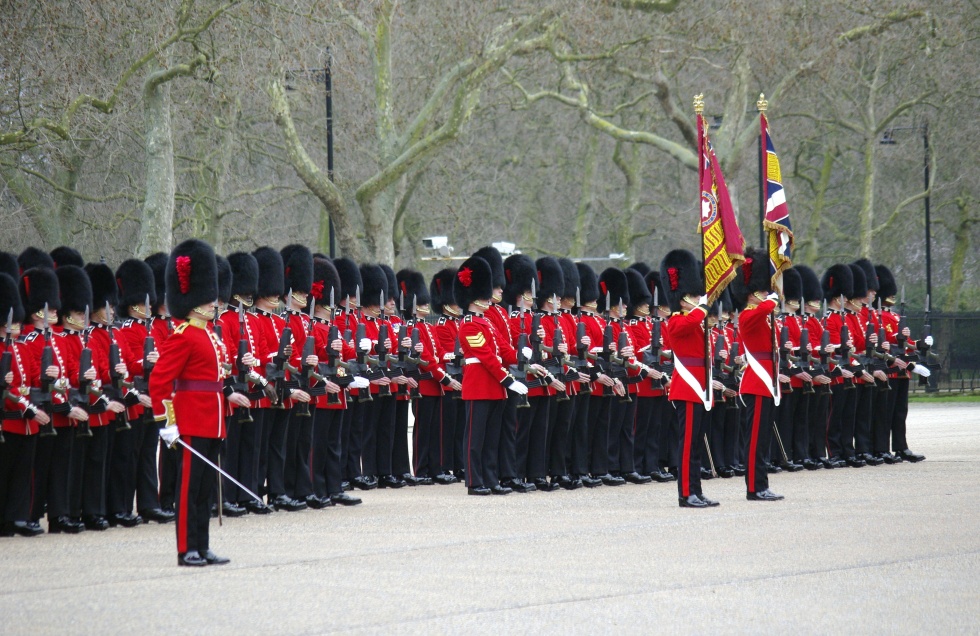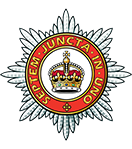Background
Headquarters Household Division sits within the larger Headquarters London District with the unique responsibility for delivering State Ceremonial and Public Duties, primarily in London & Windsor. The Headquarters is based at Horse Guards on Whitehall.
State Ceremonial includes events such as The King's Birthday Parade (Trooping the Colour), State Opening of Parliament, State Visit, the national act of remembrance at the Cenotaph and bespoke events of national importance. Public Duties include mounting the King's Life Guard at Horse Guards, The King's Guard at Buckingham Palace, the Tower of London and at Windsor Castle along with Guards of Honour and ceremonial Guards.
History
The regiments that form the Household Division have a long and proud history, mostly dating back to the time of the English Civil Wars and the Restoration in the middle of the 17th Century. Since that time they have proudly carried out a dual role as the Sovereign’s personal troops and the nation’s crack fighting soldiers.
The original Household Brigade comprised the 1st Life Guards, 2nd Life Guards and Royal Horse Guards (The Blues). The two regiments of Life Guards amalgamated in 1922 and the new regiment was initially known as The Life Guards (1st and 2nd) but this was shorted in 1928 to The Life Guards. The Royal Horse Guards (The Blues) amalgamated with The Royal Dragoons (1st Dragoons) in 1969 to become The Blues and Royals (Royal Horse Guards and 1st Dragoons).
In 1992 the two regiments of Household Cavalry were joined as a union, comprising the Household Cavalry Regiment, an armoured regiment based at Windsor, and the Household Cavalry Mounted Regiment, based at Hyde Park Barracks to carry out ceremonial duties.
The Brigade of Guards was initially made up of the Grenadier Guards, Coldstream Guards and Scots Guards. The Irish Guards was added to the Brigade on 1st April 1900 at the wish of Queen Victoria to commemorate the bravery shown by the Irish regiments during the South African Wars (Boer Wars).
On 2nd February 1915 a letter was published in The Times suggesting that a regiment of Welsh Guards should be added to the Brigade. The suggestion was met with immediate enthusiastic support from the Welsh press and many influential people, such that on 11th February 1915 the Secretary of the War Office announced that “The King has been graciously pleased to sanction an addition to the Brigade of Guards by the formation of a Battalion of Welsh Guards"
For a short period up to 1920 there was a sixth regiment of Foot Guards, the Guards Machine Gun Regiment, which provided Number 8 Guard at the King’s Birthday Parade in 1919. In December 1950 the Household Cavalry joined with the Brigade of Guards to become the Household Brigade, re-named the Household Division in July 1968; at the same time the Brigade of Guards became the Guards Division.
Each regiment of Guards Division now has one battalion while, in addition, Nijmegen Company Grenadier Guards, Number 7 Company Coldstream Guards and F Company Scots Guards are known as Public Duties Companies, based at Wellington Barracks to carry out ceremonial duties.
Command
The reigning monarch normally holds the appointment of Colonel-in-Chief of the regiments of Household Division. Each regiment has a Colonel who is normally either a member of the Royal Family or a senior officer.
|
The Life Guards: The Blues and Royals: Grenadier Guards: Coldstream Guards: Scots Guards: Irish Guards: Welsh Guards: London Guards: |
Lieutenant General Sir Edward Smyth-Osbourne KCVO CBE HRH The Princess Royal HM The Queen Consort Lieutenant General Sir James Bucknall KCB CBE HRH The Duke of Kent HRH The Princess of Wales HRH The Prince of Wales HRH The Duke of Edinburgh |
The Colonels of the regiments of Household Cavalry hold the Court appointment of Gold Stick-in-Waiting in rotation. The Lieutenant Colonel Commanding Household Cavalry normally holds the post of Silver Stick-in-Waiting.
The Field Officer in Brigade Waiting
Until 1856, the Field Officer in Brigade Waiting issued orders for the Brigade of Guards. The origin of this appointment is given in a letter dated 9th August 1711 which read:

"Gentlemen Her Majesty having thought fit that a Field Officer of the Foot Guards be always in waiting upon her Royal Person, in like manner as she is attended by an Officer of the Horse Guards, I am commanded to acquaint you with Her Majesty’s Pleasure therein, and that she expects a compliance therewith as soon as may be.
I am gentlemen, your most humble servant.
G. Granville"
The role of the Field Officer in Brigade Waiting today is largely ceremonial. The post is normally held by the Chief of Staff, London District, or by Colonel Foot Guards should the Chief of Staff be an officer of the Household Cavalry.
The Field Officer in Brigade Waiting commands the King’s Birthday Parade and on these occasions he will normally be the Commanding Officer of the Battalion from the regiment providing the Escort for the Colour.
The Field Officer in Brigade Waiting wears aiguillettes and the Royal Cipher to denote that he is a member of the Royal Household.
The Major General Commanding
On 14th July 1856 the following Brigade Order appeared:
“Her Majesty has been pleased to appoint Major-General Lord Rokeby KCB to serve on the staff of the Army, with a view to his exercising a general supervision over the battalions in England, including Aldershot; all communications having reference to the Brigade of Guards will be addressed to him in future, instead of the Field Officer in Brigade Waiting as before”.

For some years after this date the Field Officer in Brigade Waiting continued to exercise considerable control over the military affairs of the Brigade. The Major-General issued general orders, the details of which were carried out by the Field Officer.
Between 1856 and 1868 the Foot Guards were called a Division but, on 27th April 1868, the old term ‘Brigade’ was restored and it was directed that the Major General’s orders should be called ‘Brigade Orders’, while those emanating from the Field Officer should be termed ‘Sub Brigade Orders’. The latter were abolished in 1873. The Home District (now London District) was created in 1870 and placed under the command of the Major General Commanding Brigade of Guards.
In December 1950 King George VI commanded that the Household Cavalry should be brought under the command of the Major General Commanding the Brigade of Guards and that the incumbent should in future be known as the Major General Commanding the Household Brigade.
The Household Brigade was re-named the Household Division in July 1968.
The Major General appointed to command the Household Division is a Guards General and usually simultaneously holds the appointment of General Officer Commanding London District.
The Brigade Major

The Brigade Major is the principal staff officer to the Major General Commanding. The title of Brigade Major, Brigade of Guards, came into being in June 1861 and was changed to that of Household Brigade in June 1952 and Household Division in July 1968.
He is, perhaps, best known for his role at the King’s Birthday Parade when he leads the Royal Procession, accompanied by his Retinue of four troopers of the Household Cavalry.
The Garrison Sergeant Major, London District
Garrison Sergeant Majors were appointed to military districts from the mid-1800s and were largely involved with garrison administrative duties, such as billeting, furnishing fatigue parties etc.
In London, the nature of the role began to change with the appointment of GSM George Stone in 1952. Recognising that knowledge of drill and ceremonial had inevitably suffered during the war years, he took it upon himself to oversee the ceremonial for the State Funeral of King George VI, after which the role became increasingly associated with ceremonial, particularly with the preparations for the King’s Birthday Parades.
Public Duties

The regiments of Foot Guards (occasionally supported by non Household Division and Commonwealth units) provide the King’s Guard (at St. James’s Palace and Buckingham Palace), the Windsor Castle Guard and the Tower of London Guard.
In September 1818 there were 89 sentry posts which were permanently manned by the Foot Guards in Central London, found by ten separate guards mounted daily. In addition, there were three night guards then provided at the Bank of England, Drury Lane Theatre and Covent Garden Opera House, as well as the Guard provided at the Tower of London.
These ten Guards were:
King’s Guard: 22 posts. Based on St. James’s Palace and covering The Prince Regent’s establishment at Carlton House and Warwick House where Princess Charlotte had lived until 1817.
King’s Guard: Based at Buckingham House where Queen Charlotte was then living. Location of posts include: No. 7 – opposite Lord Milford’s in Birdcage Walk, and No. 27 ‘against the wall leading to Pimlico’.
Tylt Guards: 20 posts: The Guard Room was in the south wing of the Horse Guards building opposite to where the King’s Life Guard Guard Room now is. The posts were spread all around the Whitehall area including such locations as ‘The First Regiment Orderly Room in Scotland Yard’, at the corner of Lady Suffolk’s’, ‘In Downing Street’, ‘at the bomb taken at Cadiz’ (the site of the present Guards Division Memorial). This Foot Guards commitment continued until 1898.
Armoury Guard: 5 posts: at Storey Gate and Cock Pit Steps in Birdcage Walk.
British Museum Guard: 5 posts: this Guard at Montague House was not relieved by the Metropolitan Police until 31st December 1866 by which time the British Museum had moved to its present location in Bloomsbury.
Savoy Guard: 4 posts: this guard was originally on the Savoy Prison but since this building was demolished in 1817 to make way for the building of Waterloo Bridge either this was another case of forgotten sentries or the guard was on the Savoy hulks lying in the river.
Military Asylum Guard: One post on the boys’ playing ground in what became the Duke of York’s HQ in Chelsea.
York Hospital Guard: 4 posts. Founded in 1799 for soldiers invalided from foreign service, this hospital stood at the corner of Grosvenor Place and Hobart Place. The hospital was demolished in 1819.
Kensington Palace Guard: 4 posts.
Magazine Guard: Hyde Park: 4 posts. This guard lasted until the 1939/45 war.
The principal Guard Changing ceremony took place at St. James’s Palace. In 1903 King Edward VII commanded that: “In future when His Majesty or Queen Alexandra is in residence at Buckingham Palace, the King’s Guard of Household Infantry, which hitherto has always mounted at St. James’s Palace, shall instead mount in the forecourt of Buckingham Palace, the St. James’s portion of the guard to be relieved marching to Buckingham Palace to join the portion there for the customary ceremony. Consequently, the King’s Guard will, in future, include what has hitherto been the Buckingham Palace Guard, but for the purposes of accommodation will be divided into the St. James’s Palace and Buckingham Palace Detachments”.
The change was made for the first time on Tuesday 13th January 1903 when the Guard was supplied by the 2nd Bn. Coldstream Guards who marched from Chelsea Barracks, the band of the regiment playing during the relief of sentries, as at St. James’s Palace. When neither the King nor Queen is staying at Buckingham Palace the Guard will mount at St. James’s Palace as heretofore.
The ceremony at St. James’s Palace continued to be held in Friary Court until 1962, by which time the procedure was that this would be between 1st October and 31st March at weekends and when the Court was out of London, and at Buckingham Palace at other times.



 London for Ceremonial
London for Ceremonial 

